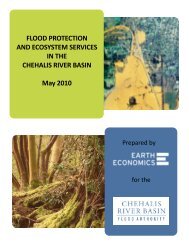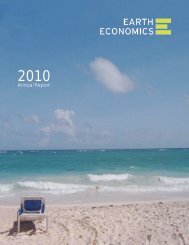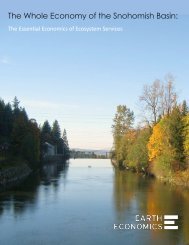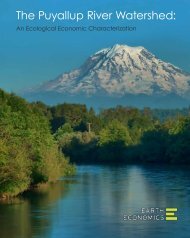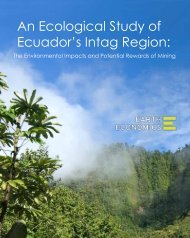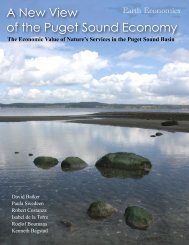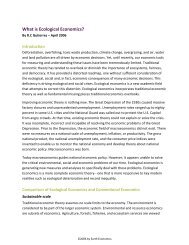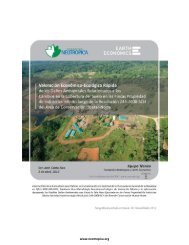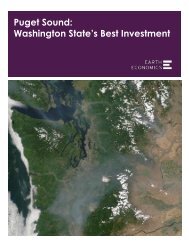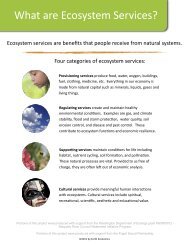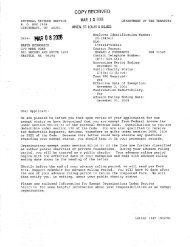The Spot Prawn Fishery: A Status Report - Earth Economics
The Spot Prawn Fishery: A Status Report - Earth Economics
The Spot Prawn Fishery: A Status Report - Earth Economics
Create successful ePaper yourself
Turn your PDF publications into a flip-book with our unique Google optimized e-Paper software.
<strong>The</strong> <strong>Spot</strong> <strong>Prawn</strong> <strong>Fishery</strong>: A <strong>Status</strong> <strong>Report</strong><br />
types) has been a cause for ecological concern<br />
for centuries. As early as 1376, the English House<br />
of Commons protested to the King about the likely<br />
damage that fishing boats dragging trawl nets<br />
were causing to seafloor vegetation (Galvin 1996).<br />
Despite the prevalence of longstanding concerns<br />
and disputes about the environmental effects of<br />
trawling, there have been few attempts to quantify<br />
trawling damage. <strong>The</strong> studies that do exist provide<br />
data that support the need for a more sustainable<br />
approach. A number of trawling bans have been<br />
established around the world to protect benthic<br />
organisms and ecosystems from the potentially<br />
destructive effects of trawling. Localized trawling<br />
bans exist in Australia, Indonesia, Canada, and<br />
in several states in the United States, including<br />
Alaska, Washington, North Carolina, and Florida.<br />
Only a small percentage of overall effort in the<br />
spot prawn fishery is trawl effort. <strong>Spot</strong> prawn<br />
trawling bans are in place for ecological reasons<br />
in Alaska, British Columbia, and Washington’s<br />
inshore fishery (a phase-out plan is being developed<br />
for the coastal fishery). Many of the managers<br />
and scientists interviewed for the <strong>Status</strong><br />
<strong>Report</strong> questioned whether, given spot prawn<br />
biology, a trawl fishery was even “appropriate.”<br />
<strong>Spot</strong> prawn trawl gear is non-selective and<br />
destructive, an important ecological consideration<br />
given the sensitivity of the spot prawn habitat<br />
and associated species (e.g., bocaccio). Fishing for<br />
spot prawns with traps or pots is more likely to<br />
result in an ecologically sound and economically<br />
viable fishery for spot prawns and for ecologically<br />
interrelated species such as rockfish. <strong>Spot</strong> prawn<br />
trap fisheries are already viable and lucrative.<br />
Moreover, trap-caught prawns offer a range of<br />
higher-value product types that could result in<br />
an even more profitable fishery in the long run.<br />
Serious consideration should be given to phasing<br />
out the trawl fishery throughout the spot prawn’s<br />
range. <strong>The</strong>re is no doubt that there will be shortterm<br />
economic costs associated with phasing<br />
trawls. On the other hand, reducing the ecological<br />
impact of fishing has been proven time and again<br />
to be investment in natural capital that provides a<br />
more than substantial return in the long run.<br />
1.4 Management should be Systemic and<br />
Spatial in Orientation<br />
Precautionary management is spatial and multidimensional<br />
in orientation and calls for concentration<br />
on spatial stock structure and the processes<br />
or factors that influence it. Management systems<br />
that emphasize the use of overall quotas<br />
have not proven particularly useful in the management<br />
of shellfish species that have a primarily sessile<br />
adult phase—a characteristic that often makes<br />
these types of animals susceptible to serial depletion<br />
(Orensanz et al. 1998). According to Garcia<br />
(1996), the potential risk of negatively affecting<br />
through fishing pressure the fecundity of latematuring<br />
shrimp like spot prawns is high.<br />
<strong>Spot</strong> prawn fecundity is naturally very low.<br />
Compared to finfish like cod, the number of eggs<br />
released by a female spot prawn is significantly<br />
lower. <strong>The</strong> species’ reproductive potential to create<br />
large year classes is therefore limited. This is particularly<br />
significant for management because the fishery<br />
tends to target larger animals; i.e., females. Dr. Paul<br />
Anderson of the Kodiak Fisheries Research Center<br />
argues that in targeting the largest animals, the fishery<br />
is “hitting the oldest, most fecund, and most<br />
valuable animals the hardest, and thereby destroying<br />
the chances of maintaining a viable spot prawn<br />
population.” <strong>The</strong> fishery would be better off targeting<br />
smaller, younger male animals, some of which<br />
would have anyway naturally died off before<br />
changing sex and becoming sexually mature<br />
(Paul Anderson, KFRC. Pers. comm., August 2001).<br />
Jim Boutillier of Fisheries and Ocean Canada<br />
offers an alternative view. In his view, future forecasting<br />
in order to protect older, larger animals is<br />
critical. Ensuring that the population has a sufficient<br />
number of females, and thus is large and<br />
strong enough to be sustainable, is essential.<br />
British Columbia’s spawner index is a real-time<br />
assessment tool that ensures that the brood stock<br />
is protected and the female spot prawn population<br />
healthy enough to sustain the population. It offers<br />
the possibility for real-time decision-making and<br />
management—the crux of the sustainability riddle.<br />
<strong>The</strong> development of recruitment-related reference<br />
points, rather than quotas, is also seen as central<br />
to sustainable spot prawn management. In order<br />
for quota systems to be effective, the effect of fishing<br />
on the population needs to be fully understood.<br />
This requires a minimum of 15–20 years of<br />
data (Zheng et al. 1993). <strong>The</strong> authors note that the<br />
research phase may be even longer if strong environmental<br />
conditions or environmental variability<br />
affect recruitment. This has been shown to be the<br />
case with some pandalid species.<br />
51



